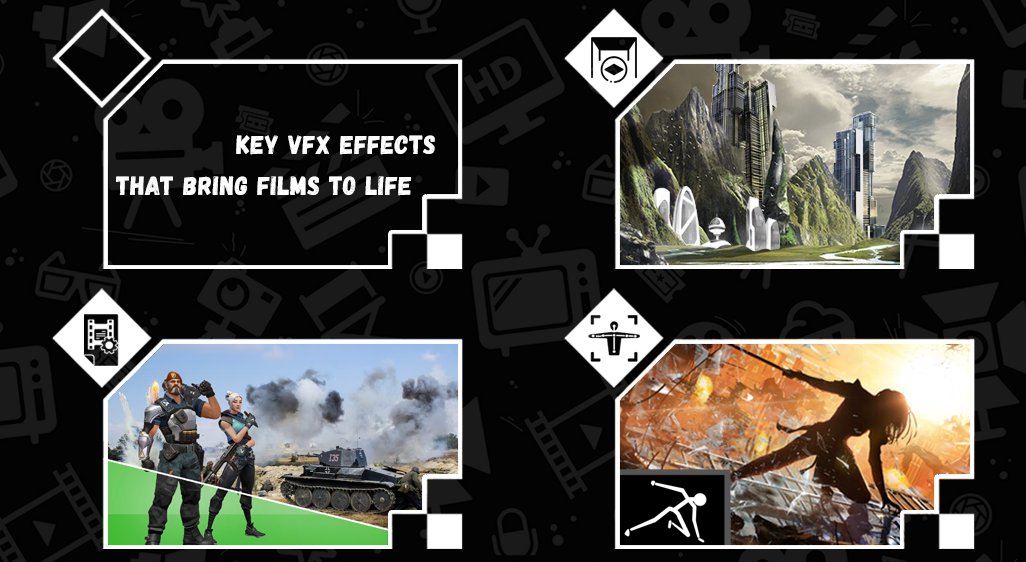One of the most significant parts of modern filmmaking is visual effects (VFX). VFX assists filmmakers in creating a completely new universe of imagination that is outside the range of real-life physics. The use of visual effects in films has transformed the way tales are delivered, allowing filmmakers to bring their wildest fantasies to life on the big screen. This blog will go through some of the key types of VFX that are used to bring movies to life.
CGI (Computer-Generated Imagery)
Computer-Generated Imagery (CGI) is one of the most used types of visual effects (VFX) in modern filmmaking. It entails producing digital images or models using specialized software and gear to augment or replace live-action films. CGI may be used to produce everything from fantasy animals and environments to realistic portrayals of historical events and places.
The process of developing CGI begins with pre-production when the VFX crew collaborates closely with the director and other creative departments to create and design the visual effects for the film. The VFX team may employ reference materials or motion capture data during production to verify that the digital elements match the live-action video in terms of lighting, texture, and movement.
The final VFX shots are made in the post-production phase, which employs specialized software and technology to render the digital images and integrate them into the live-action film. To obtain realistic results, the procedure can be extremely time-consuming and expensive, as it takes expert artists, powerful computers, and complex software. Some of the most well-known instances of CGI in the film include the realistic surroundings and monsters in James Cameron’s Avatar, the epic combat scenes in The Lord of the Rings trilogy, and the seamless mixing of live-action footage and CGI in Marvel’s Avengers flicks.
Motion Capture
Motion capture, or mocap, is a process that includes recording the movements of actors or objects with specialized cameras and sensors and converting them into digital animation. Mocap is used to generate realistic and lifelike character animations, particularly for monsters and characters that are difficult to portray by hand.
The mocap method begins with the actor or item being fitted with sensors that record their movements. These sensors are then tracked using specialized cameras, which capture data that is utilized to generate a digital representation of the figure or item. This model can then be animated and inserted into the film.
Mocap can be used to produce complicated movements and behaviors that would be difficult to achieve using typical animation techniques. It is frequently utilized in films with a vast number of creatures or people, such as The Chronicles of Narnia or Guardians of the Galaxy. Gollum from The Lord of the Rings trilogy, Caesar from the Planet of the Apes franchise, and the Na’vi from Avatar are some of the most notable examples of motion capture in film.
Matte Painting
Matte painting is a method that includes creating a painted background for use in a live-action shot. The painted background is then blended with the live-action film to produce a seamless and realistic-looking setting. Matte painting is frequently used to create large-scale scenes such as cities, landscapes, and other such locations. This approach is used to construct environments that are difficult or impractical to reproduce in real life. Some of the most memorable matte paintings in film are the opening shot of Star Wars: A New Hope, the cityscape of Blade Runner, and the floating mountains of Avatar.
Compositing
Compositing is the technique of integrating several elements into a single image, such as live-action films, CGI, and matte paintings. It is used to generate complicated visual effects such as explosions, flames, and smoke, as well as to make smooth transitions between scenes. The composting process begins with an analysis of the live-action video to determine which aspects need to be added or enhanced using VFX. The VFX crew then develops the necessary assets, such as CGI, matte paintings, or digital composites, and uses specialized software to integrate these with the live-action film.
Compositing necessitates meticulous attention to detail and a great eye for composition, as even minor errors can destabilize the illusion of realism. Some of the most well-known examples of compositing in the film are the climactic battle sequence in The Avengers and the destruction of the Death Star in Star Wars.
Practical Effects
Practical effects are visual effects made with tangible things like miniatures or animatronics. They are frequently utilized to make lifelike animals, prosthetics, and props. Practical effects can be costly and time-consuming to make, but they can also provide a level of realism that CGI cannot match. Practical effects are frequently utilized in conjunction with CGI and other VFX techniques to produce a more realistic and credible effect. They can also be utilized to generate effects that are difficult to achieve with CGI alone. The chest-burster scene in the first Alien film is one of the most iconic examples of practical effects in movies. The scene depicts an animatronic beast breaking out of an actor’s chest, producing a visceral and horrifying moment.
Visual effects, or VFX, have transformed the film industry by enabling filmmakers to build fantastic and inventive worlds that would be impossible to represent in real life. VFX can breathe new life into movies by creating spectacular and realistic images that attract spectators and bring tales to life. Visual effects have become an essential component of contemporary filmmaking. They provide filmmakers with the ability to construct fanciful worlds, bring characters to life, and improve the overall movie experience. The VFX techniques outlined above are just a few instances of the vast array of techniques that may be employed to bring films to life.












